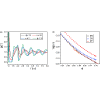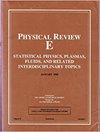Theoretical analysis of the structure, thermodynamics, and shear elasticity of deeply metastable hard sphere fluids
IF 2.4
3区 物理与天体物理
Q1 Mathematics
引用次数: 0
Abstract
The structure, thermodynamics, and slow activated dynamics of the equilibrated metastable regime of glass-forming fluids remain a poorly understood problem of high theoretical and experimental interest. We apply a highly accurate microscopic equilibrium liquid state integral equation theory, in conjunction with naïve mode coupling theory of particle localization, to study in a unified manner the structural correlations, thermodynamic properties, and dynamic elastic shear modulus in deeply metastable hard sphere fluids. Distinctive behaviors are predicted including divergent inverse critical power laws for the contact value of the pair correlation function, pressure, and inverse dimensionless compressibility, and a splitting of the second peak and large suppression of interstitial configurations of the pair correlation function. The dynamic elastic modulus is predicted to exhibit two distinct exponential growth regimes with packing fraction that have strongly different slopes. These thermodynamic, structural, and elastic modulus results are consistent with simulations and experiments. Perhaps most unexpectedly, connections between the amplitude of long wavelength density fluctuations, dimensionless compressibility, local structure, and the dynamic elastic shear modulus have been theoretically elucidated. These connections are more broadly relevant to understanding the slow activated relaxation and mechanical response of colloidal suspensions in the ultradense metastable region and deeply supercooled thermal liquids in equilibrium.

深层可蜕变硬球流体的结构、热力学和剪切弹性理论分析
玻璃态流体的平衡蜕变体系的结构、热力学和慢活化动力学仍然是一个鲜为人知的问题,具有很高的理论和实验价值。我们应用高精度的微观平衡液态积分方程理论,结合粒子定位的天真模式耦合理论,以统一的方式研究了深度蜕变硬球流体的结构相关性、热力学性质和动态弹性剪切模量。研究预测了独特的行为,包括对相关函数接触值、压力和反无量纲压缩性的发散反临界幂律,以及对相关函数第二峰的分裂和对间隙构型的大幅抑制。据预测,动态弹性模量会呈现出两个截然不同的指数增长区,其填料分数的斜率也大不相同。这些热力学、结构和弹性模量结果与模拟和实验结果一致。也许最出人意料的是,理论上阐明了长波长密度波动幅度、无量纲可压缩性、局部结构和动态弹性剪切模量之间的联系。这些联系更广泛地关系到如何理解处于超致密瞬变区域的胶体悬浮液和处于平衡状态的深过冷热液体的缓慢活化弛豫和机械响应。
本文章由计算机程序翻译,如有差异,请以英文原文为准。
求助全文
约1分钟内获得全文
求助全文
来源期刊

Physical review. E
物理-物理:流体与等离子体
CiteScore
4.60
自引率
16.70%
发文量
0
审稿时长
3.3 months
期刊介绍:
Physical Review E (PRE), broad and interdisciplinary in scope, focuses on collective phenomena of many-body systems, with statistical physics and nonlinear dynamics as the central themes of the journal. Physical Review E publishes recent developments in biological and soft matter physics including granular materials, colloids, complex fluids, liquid crystals, and polymers. The journal covers fluid dynamics and plasma physics and includes sections on computational and interdisciplinary physics, for example, complex networks.
 求助内容:
求助内容: 应助结果提醒方式:
应助结果提醒方式:


